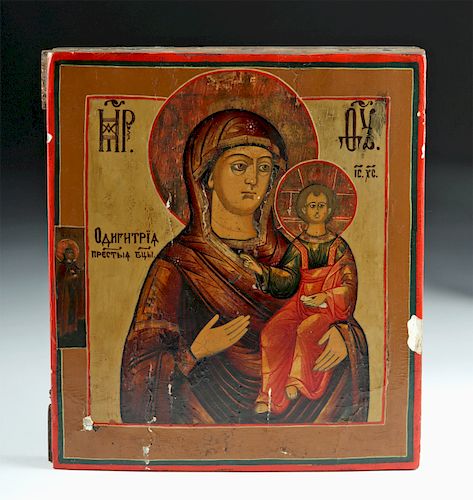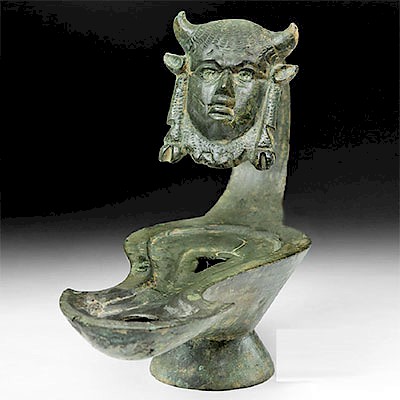19th C. Russian Wooden Icon - Virgin & Child
Lot 209b
About Seller
Artemis Fine Arts
686 S Taylor Ave, Ste 106
Louisville, CO 80027
United States
Selling antiquities, ancient and ethnographic art online since 1993, Artemis Gallery specializes in Classical Antiquities (Egyptian, Greek, Roman, Near Eastern), Asian, Pre-Columbian, African / Tribal / Oceanographic art. Our extensive inventory includes pottery, stone, metal, wood, glass and textil...Read more
Estimate:
$900 - $1,400
Absentee vs Live bid
Two ways to bid:
- Leave a max absentee bid and the platform will bid on your behalf up to your maximum bid during the live auction.
- Bid live during the auction and your bids will be submitted real-time to the auctioneer.
Bid Increments
| Price | Bid Increment |
|---|---|
| $0 | $25 |
| $300 | $50 |
| $1,000 | $100 |
| $2,000 | $250 |
| $5,000 | $500 |
| $10,000 | $1,000 |
| $20,000 | $2,500 |
| $50,000 | $5,000 |
| $100,000 | $10,000 |
| $200,000 | $20,000 |
About Auction
By Artemis Fine Arts
Sep 27, 2018
Set Reminder
2018-09-27 10:00:00
2018-09-27 10:00:00
America/New_York
Bidsquare
Bidsquare : Antiquities | Asian | Ethnographic
https://www.bidsquare.com/auctions/artemis-gallery/antiquities-asian-ethnographic-3469
Featuring classical antiquities, ancient and ethnographic art from cultures encompassing the globe. Artemis Fine Arts info@artemisgallery.com
Featuring classical antiquities, ancient and ethnographic art from cultures encompassing the globe. Artemis Fine Arts info@artemisgallery.com
- Lot Description
Eastern Europe, Russia, ca. 19th century CE. Finely executed in egg tempera and gold leaf on wood, this Russian icon presents the Virgin Hodegetria ("She who shows the way"), the composition depicting the Mother of God holding the Christ child in one arm, as he makes a blessing gesture. On her shoulders and head, Mary wears a triple, star-shaped cross, which is an ancient symbol of her virginity - before, during, and following the birth. The figure depicted to her left in the border most likely represents a patron saint of the people who commissioned the painting. Size: 8.75" L x 7.5" W (22.2 cm x 19 cm)
Note that in this composition, the artist only depicted Mary's head and shoulders, in concordance with tradition. This invites and prompts the viewer to gaze upon Christ with the subtle inclination of Mary's visage, particularly given those expressive eyes. The Christ Child is characteristically depicted in a rigid, vertical pose - wearing regal vestments. A lovely example inspired by the icon of the Hodegetria that arrived in Constantinople from Jerusalem, where it was found in the 5th century by the sister-in-law of Emperor Theodosius II. According to Alfredo Tradigo's "Icons and Saints of the Eastern Orthodox Church" (2004), "Hidden from the Iconoclasts in a wall at the Hodegon Monastery, it was later carried to the city walls when Constantinople lay under siege and became, under the Palaiologan dynasty (1261-1453), a major palladium protecting the capital. Copies made their way to Rome, the Near East, the Balkans, and Russia." (Tradigo, Icons and Saints of the Eastern Orthodox Church, p. 169)
Given its relatively intimate scale, this icon most likely was kept in someone’s home. According to Jeanne Marie Warzeski, scholar and curator of the "Windows into Heaven" exhibition at the North Carolina Museum of History, "In the early Byzantine Empire, the home became the primary base for the development of icon veneration. Throughout the ensuing centuries, icons continued to receive honor in homes and churches. To this day, many Orthodox Christians create for prayer and meditation in their home a krasny ugol, or "beautiful corner," where family icons are placed. Guests entering a house customarily honor the icons in the corner by crossing themselves before the objects. An oil lamp is set near the icons and is lit daily, according to Orthodox tradition."
Icons (icon means "image" in Greek) are sacred objects within the Eastern Orthodox Christian tradition. Found in homes as well as churches, these painted images depict holy persons and saints as well as illustrate scenes from the Scriptures. Icons are not worshiped, but are instead venerated for their ability to focus the power of an individual's prayer to God. As a focus for prayers and meditation for believers, icons serve as "windows into heaven."
Provenance: private East Coast, USA collection
All items legal to buy/sell under U.S. Statute covering cultural patrimony Code 2600, CHAPTER 14, and are guaranteed to be as described or your money back.
A Certificate of Authenticity will accompany all winning bids.
We ship worldwide and handle all shipping in-house for your convenience.
#138598Losses to pigment, gold leaf, and gesso as shown. Some repainting to red border and possibly areas of the interior composition but well done. Areas of craquelure. Wired for suspension on verso.Condition
- Shipping Info
-
All shipping is handled in-house for your convenience. Your invoice from Artemis Gallery will include shipping calculation instructions. If in doubt, please inquire BEFORE bidding for estimated shipping costs for individual items.
-
- Buyer's Premium



 EUR
EUR CAD
CAD AUD
AUD GBP
GBP MXN
MXN HKD
HKD CNY
CNY MYR
MYR SEK
SEK SGD
SGD CHF
CHF THB
THB













